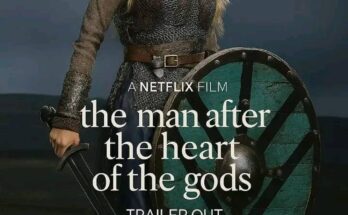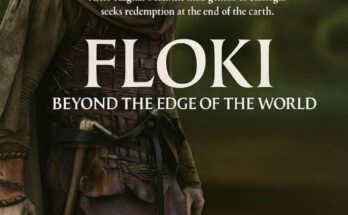Skald, Netflix New Movie, Where Songs Foretell Doom, and Warriors Carve Destiny in Steel.
In the dim light of a cold northern dawn, the world of Skald awakens with a pulse both ancient and foreboding, a place where the songs of men are not mere echoes of joy or sorrow but harbingers of doom, and where warriors carve their destinies in steel as surely as the rivers carve valleys through stone. Netflix’s new cinematic venture into this mythic landscape delivers an experience that feels both epic and intimate, a story told as much in the clash of axes and the timbre of a singer’s voice as it is in dialogue or plot. From the opening frames, the film establishes a tone of inevitability. Snow-laden forests stretch endlessly, and the faint strains of a harp, almost drowned by the wind, carry words that seem to weigh on the world itself. Each note hints at what is to come, a subtle orchestration of fate and terror that threads through every scene. Skald, in this sense, is not just a character or a film but a living, breathing saga where the acts of men and women ripple across time, leaving marks that cannot be undone. The cinematography is as much a storytelling tool as the script, with sweeping shots of frozen fjords and desolate villages setting the stage for the human drama that unfolds. The camera lingers on the faces of the warriors, capturing not just their fear or determination but the silent recognition that their lives are part of a narrative far larger than themselves. In this world, music is weapon and oracle alike. The titular Skald, a wandering singer whose songs can foretell misfortune and stir courage, is the axis around which the story spins. Unlike traditional heroes, the Skald does not wield a sword or shield in the conventional sense, yet the power in their voice is no less lethal. When a melody predicts the fall of a chieftain or the approach of a violent storm, it is not mere superstition but a compulsion to act, to respond, to carve one’s destiny before it is consumed by the inevitability sung into the air. The film’s narrative structure mirrors this interplay of prophecy and action, with events unfolding in a rhythm that mimics the cadence of a saga told aloud around a fire. Characters are often seen reacting to portents delivered in verse, their decisions shaped by what they have heard and what they fear is coming. It is a world where knowing the future is both a blessing and a curse, and where silence in the face of a warning can be as deadly as a poorly swung blade. The warriors of Skald are not merely soldiers; they are embodiments of the human struggle against fate. Each carries weapons forged with care and ritual, steel kissed by fire and shaped with intention, symbols of the choices they make in the face of prophecy. Battles are choreographed with a visceral realism that leaves the audience feeling the weight of every swing, the impact of every strike. Blood mingles with snow, steel bites against steel, and yet there is a rhythm to the chaos, a poetry in the violence that echoes the songs that foretell it. Beyond the spectacle of combat, the film delves into the psychology of those bound by honor and fear. Leaders wrestle with the implications of foretold events, questioning whether the future is fixed or if their own courage—or cowardice—can alter the path laid before them. Alliances are fragile, forged as much from mutual survival as from loyalty, and betrayal lurks like a shadow in the corners of every hall. The Skald’s songs serve as a mirror to this uncertainty, reflecting not just what is to come but the inner turmoil of those who must face it. The dialogue itself is sparse yet weighty, often allowing the silence between words to resonate as strongly as the spoken lines. In these pauses, viewers sense the dread of impending calamity, the quiet contemplation of a warrior preparing to face odds that may be insurmountable. This economy of speech amplifies the power of music and action, reinforcing the idea that in this world, the most profound truths are often unspoken. Visually, the film is a feast for those who revel in atmospheric storytelling. The use of light and shadow enhances the feeling of an omnipresent fate, with dawns that glow briefly before being swallowed by night, and torches that flicker uncertainly against stone walls. Costumes and set designs are meticulously detailed, grounding the mythic elements in a tangible reality that allows the audience to fully inhabit the world. Even the smallest props—a well-worn shield, a frayed cloak—carry narrative weight, hinting at histories, victories, and losses that extend beyond the frame. At its core, Skald is a meditation on the intersection of art, destiny, and human resilience. The film raises profound questions about the nature of fate and free will, asking whether foreknowledge empowers or enslaves, and whether courage is defined by action in spite of prophecy or by the wisdom to avoid unnecessary conflict. By making music itself a vehicle for foretelling events, the narrative blurs the lines between entertainment and existential reflection, inviting the audience to consider the stories in their own lives that seem written before they are lived. The score of the film is a standout, composed to reflect both the beauty and terror inherent in this world. Lush, haunting melodies intertwine with percussive, almost brutal compositions during battle sequences, underscoring the duality of creation and destruction, joy and sorrow. The music is inseparable from the storytelling, much like the Skald’s role within the plot, reinforcing the idea that sound can shape destiny as much as action. Characters are given space to evolve, their arcs intertwined with the overarching narrative of foreseen doom. Relationships develop and fracture in ways that feel organic, often catalyzed by the revelations of the Skald’s songs. Romantic entanglements, rivalries, and mentorships are all rendered with a sensitivity that balances the film’s epic scale, ensuring that the human element remains at the forefront amid the larger mythic tableau. The pacing of the film is deliberate, allowing tension to build gradually, and yet it never lingers unnecessarily. Each scene, each note, and each strike of steel carries purpose, contributing to a cumulative sense of inevitability and grandeur. As the story progresses, the audience comes to understand that in this world, survival is not merely about skill or strength but about interpretation, timing, and the courage to confront truths that are both unavoidable and uncomfortable. Netflix’s Skald is a triumph of immersive world-building and narrative ambition. It blends the visceral thrill of combat cinema with the reflective, almost meditative qualities of an epic poem brought to life. Viewers are left not only entertained but also provoked to consider the forces—seen and unseen—that shape human experience, the ways in which stories themselves influence action, and the enduring power of song to both warn and inspire. By the film’s conclusion, the interplay of music, destiny, and human resolve coalesces into a resonant statement about the nature of life in a world where every note carries weight, and every swing of steel has the potential to alter fate. Skald is more than a movie; it is a sensory journey, a mythic meditation, and a testament to the timeless allure of stories in which the threads of fate are woven tightly with the courage and choices of those who dare to act. The haunting melodies linger long after the screen fades to black, a reminder that in some worlds, the future sings to us before we even step into the fray, and that the legacy of a warrior is measured not just in victories but in the way they meet the destiny foretold in song.



